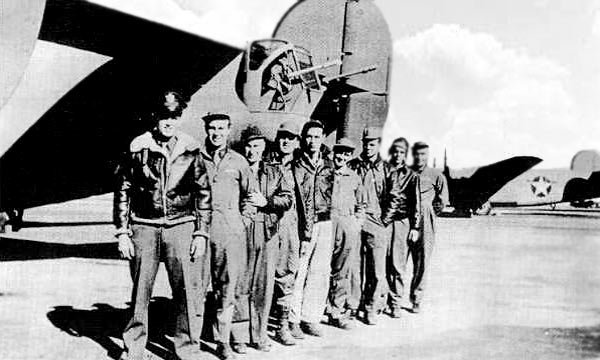|
|
 |
| THE PLANE |
| The Lady Be Good, B-24D # 4124301, was one of 639 built by Consolidated in San Diego,
California. The B-24D had a wingspan of 110 ft, weighed 56,000 pounds loaded, carried 8,000 pounds of
bombs. Maximum speed was near 300 MPH, cruising speed 175 MPH, range 2850 miles, and had a service ceiling
of 28,000 ft. For armament it was fitted with eleven .50 Cal. Machine guns. It was powered by four Pratt
and Whitney R-1830 engines of 1200 HP each. Consolidated built more than 18,000 Liberators. The LBG was
assigned to the 514th Squadron, 376th Bomb Group, 9th Air Force. |
| THE CREW |

Lady Be Good Crew - Public Domain |
| · Left to Right · |
| 1st Lt. William J. Hatton · Pilot · Whitestone,
N.Y. |
| 2nd Lt. Robert F. Toner · Co-Pilot · North
Attelboro, Mass. |
| 2nd Lt. Dp Hays · Navigator · Lee’s
Summit, Missouri |
| 2nd Lt. John S. Woravka · Bombardier · Cleveland,
Ohio |
| T/Sgt. Harold J. Ripslinger · Flt. Engineer · Saginaw,
Michigan |
| T/Sgt. Robert E. Lamotte · Radio Operator · Lake
Linden, Michigan |
| S/Sgt. Guy E. Shelley · Gunner · New
Cumberland, Pa. |
| S/Sgt. Vernon L. Moore · Gunner · New
Boston, Ohio |
| S/Sgt. Samuel R. Adams · Gunner · Eureka,
Ill. |
|
| THE MISSION |
| On Apr. 4, 1943, the B-24D Lady Be Good departed Soluch airfield in Libya on it's very
first combat mission. This was the 376th Bomb Group mission 109, and along with the LBG were 24 B-24Ds.
The 512th Sqdn. Was A section of the 1st flight with seven aircraft. The 513th Sqdn. was the 2nd flt.
with seven aircraft. The 514th B section first flt. had six aircraft. The 515th second flt. with five
aircraft. The LBG was in the 514th B section 1st flt. They were to fly to Crotone, on the SE side of
Italy, cross over and come in over the water and bomb Naples. The flight would be approximately nine
hours. Flights from Soluch were notorious for their high number of turn backs. The sand was responsible
for a large number of problems. This mission was no different as many B-24s returned to Soluch shortly
after takeoff due to malfunction. For an unknown reason, thirty minutes before reaching Naples the Pilot
of the LBG aborted the mission, dropped their bombs in the ocean and headed back for Soluch. I cannot
find where any reason was ever given for the abort. The Navigator 2nd Lt. Hays was now facing a task
for which he was not prepared, having received minimum training of 20 weeks and very little night time.
A great catastrophe was in the making.
|
| NAVIGATOR'S FATAL DECISIONS |
| The Lady Be Good was now on the way back to Soluch Airfield. Even using dead reckoning
(time and distance) they would be close to their destination. The pilot, Lt. Hatton requested an inbound
bearing from Benina tower's HF/DF equipment covering Benghazi which was 30 miles north of Soluch. He
was informed he was on an inbound magnetic bearing of 330 degrees. The reciprocal heading was used leading
the LBG to believe they were still over the Mediterranean. The inbound bearing of 330 degrees from Benina
tower could also have been an outbound bearing of 150 degrees. So the LBG continued it's fateful flight
into the unknown. They were actually on the 150 degree outbound bearing, which could have been verified
by turning left and noting a decrease in the reported bearing values. The Navigator made no attempt to
verify if he was inbound or outbound. It is proper to mention here that the Navigator logs were recovered
completely intact, and there were no entries in the log since the return trip started. The final judgement
here has to be that the Navigator was non functioning and was hopelessly lost. No attempt was made to
verify the actual position in relation to the Benina tower. It is hard to believe the pilot blundered
on through the darkness almost two more hours into the unknown. All of the other B-24s returned safely.
It was reported that a B-24 was heard over Soluch just before midnight. It should also be pointed out
that the major navigational instruments such as radios, ADF, and magnetic compass were all working properly
when the wreckage was recovered. |
|
|
|
|
|

